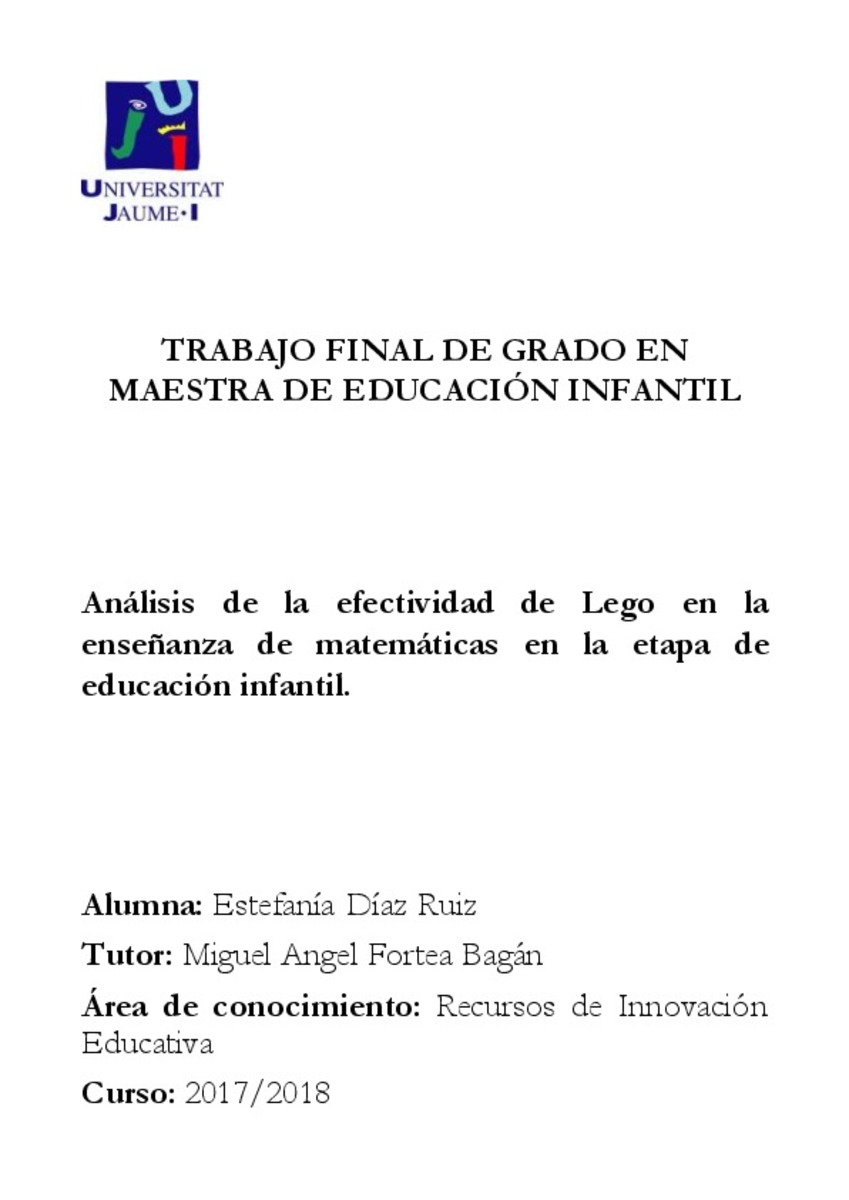Mostrar el registro sencillo del ítem
Análisis de la efectividad de Lego en la enseñanza de matemáticas en la etapa de educación infantil
| dc.contributor.author | Díaz Ruiz, Estefanía | |
| dc.contributor.other | Fortea Bagán, Miguel Angel | |
| dc.contributor.other | Universitat Jaume I. Departament de Pedagogia i Didàctica de les Ciències Socials, la Llengua i la Literatura | |
| dc.date.accessioned | 2018-12-12T13:25:10Z | |
| dc.date.available | 2018-12-12T13:25:10Z | |
| dc.date.issued | 2018 | |
| dc.identifier.uri | http://hdl.handle.net/10234/178052 | |
| dc.description | Treball Final de Grau en Mestre o Mestra d'Educació Infantil. Codi: MI1040. Curs acadèmic: 2017/2018 | ca_CA |
| dc.description.abstract | Este trabajo de final de grado (TFG) tiene como principal objetivo analizar la efectividad de Lego en la enseñanza de matemáticas en alumnado de educación infantil. Se ha llevado a cabo una investigación cuasi experimental con pretest y post test a una única muestra. Esta muestra es un aula mixta de infantil de 3 años con un total de 23 sujetos. Durante la investigación se ha pasado un total de tres pruebas, cada una de ellas contaba con un test inicial de diagnóstico (pretest), 3 sesiones de intervención con Lego y su respectivo test final (post test). En estas pruebas se trabaja diferentes conceptos matemáticos adecuados a su edad, los cuales ya habían sido trabajados y no adquiridos o todavía no habían sido enseñados. Los conceptos a trabajar han sido, en la prueba 1 la seriación, en la prueba 2 los números 1, 2 y 3, la grafía del 1 y 2 y el concepto de cantidad del número 1 y 2 y, por último, en la prueba 3 se trabajó la direccionalidad. El material utilizado en mayor parte ha sido material de Lego aunque se ha complementado con otros materiales como tarjetas. Los resultados generales obtenidos después de aplicar la “Prueba de signos” muestran diferencias significativas las cuales confirman que el alumnado ha aprendido con el Lego. | ca_CA |
| dc.description.abstract | This final degree project (GFR) has as main objective to analyze the effectiveness of Lego in teaching mathematics in children in their pre-school education. A quasi-experimental research with pre-test and post-test was carried out on a single sample. This sample is a mixed classroom of 3- year-old children with a total of 23 subjects. During the investigation, a total of three tests were passed, each of them had an initial diagnostic test (pretest), 3 intervention sessions with Lego and their respective final test (post test). In these tests, different mathematical concepts appropriated to their age are treated, which had already been treated and not acquired or had not yet been taught. The concepts to work have been: in test 1 the seriation, in test 2 the numbers 1, 2 and 3, the graph of the 1 and 2 and the concept of quantity of the number 1 and 2, and in test 3 the directionality. The material used in most cases has been Lego material, although it has been supplemented with other materials such as cards. The general results obtained after applying the "Sign Test" show significant differences which confirm that the students have learned with the Lego. | ca_CA |
| dc.format.extent | 21 p. | ca_CA |
| dc.format.mimetype | application/pdf | ca_CA |
| dc.language.iso | spa | ca_CA |
| dc.publisher | Universitat Jaume I | ca_CA |
| dc.rights | Licencia CC-BY-NC-ND | ca_CA |
| dc.rights | Attribution-NonCommercial-NoDerivatives 4.0 Internacional | * |
| dc.rights.uri | http://creativecommons.org/licenses/by-nc-nd/4.0/ | * |
| dc.subject | Grau en Mestre o Mestra d'Educació Infantil | ca_CA |
| dc.subject | Grado en Maestro o Maestra de Educación Infantil | ca_CA |
| dc.subject | Bachelor's Degree in Preschool Education | ca_CA |
| dc.subject | matemáticas | ca_CA |
| dc.subject | Lego | ca_CA |
| dc.subject | educación infantil | ca_CA |
| dc.subject | maths | ca_CA |
| dc.subject | Lego | ca_CA |
| dc.subject | pre-school education | ca_CA |
| dc.title | Análisis de la efectividad de Lego en la enseñanza de matemáticas en la etapa de educación infantil | ca_CA |
| dc.type | info:eu-repo/semantics/bachelorThesis | ca_CA |
| dc.educationLevel | Estudios de Grado | ca_CA |
| dc.rights.accessRights | info:eu-repo/semantics/openAccess | ca_CA |
Ficheros en el ítem
Este ítem aparece en la(s) siguiente(s) colección(ones)
-
Grau en Mestre o Mestra d'Educació Infantil [1149]
MI1040; MI1840








